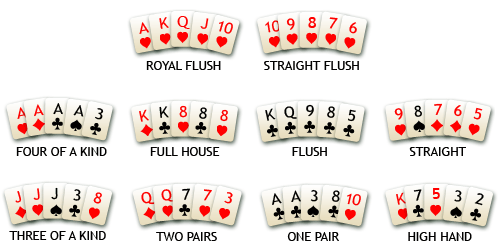Covering the fundamentals of poker is a bit dry, but if you’re reading this right now — you definitely need it. Why should you have to go through your poker career not grasping the things that other players seem to know by memory?
If you’re someone that gets into the WSOP, you’ll find that those players definitely rely on strong poker theory and fundamentals. While everything looks chaotic and by chance, it’s anything but. There’s just way too much money on the table. Now, you might not be someone that’s playing at those stakes, but that’s no excuse to just let good theory fly out the window.
It doesn’t get more fundamental than understanding the ranking of poker hands. If you’re going to play any type of poker, you need to know what your rankings really are.
There are 52 cards in a standard deck, and the ranking of the cards starts high: ace, king, queen, jack, 10, 9, 8, 7, 6, 5, 4, 3, 2. There’s no suit ranking in most online poker games, which means that the King of Hearts and the King of Spades are equal.

In Texas Hold’Em, you get two cards to go with. Those are your hole cards.
The first three cards dealt are known as the flop. And that’s where the other rankings come in.
First, you have the straight flush. This is the highest type of poker hand — five cards of the same suit in sequence. If you get two players that both have straight flushes, the one that has the higher top card is the winner. Keep in mind that an ace can be counted as low and high, so it’s important to look — 5-4-3-2-A is not a high flush — it’s a low flush, as the ace is played “low”. A-K-Q-J-10 would be a high flush, where the ace is played “high” (though, this is technically a Royal Flush, and is higher than the standard Straight Flush.)
Keep in mind that your flush cannot “turn the corner”, so 4-3-2-A-K is not valid at all. However, 5-4-3-2-A (all the same suit) is a valid flush.
Make sure that you have all of the same suit, otherwise it’s just a straight.
Next, we have the four of a kind. It’s pretty straight forward — four cards of the same rank. Four queens, four kings, four jacks. To break a tie, the 5th card is known as a kicker; Between two fours of a king, it’s all about who has the higher set. So 5-5-5-5-2 would be beaten by 7-7-7-7-3. If two players have exactly the same “best hand” in community games, then the kicker decides. So if there’s J-J-J-9 on the table, the player that has K-7 will beat a player that has Q-9 — the king obviously beats the queen. But what if one player has say, 8-2 and another has 6-5? The 9 kicker on the board makes the best hand for both of them.
Let’s move on to the Full House. It’s often called a “boat” in poker commentary, so make sure that you make a mental note of this when you read that stuff. It consists of three cards of one rank and two cards of another — so you can have three eights and two sixes. This is referred to as “eights full of sixes” or “eights on sixes”. So when it’s time to compare full houses, the rank of the three cards determines which one is higher. So 10-10-10-6-6 would beat 9-9-9-3-3. If the three of a kind are equal, then it goes to the rank of the pairs.
The flush is one of the most popular rankings. A flush can win you a lot of money — but remember, you can be beaten by any of the higher rankings. Keeping an open mind is really important for this reason. A flush is simply five cards of the same suit, in any order. So if you have (hearts) 5-8-2-Q-3, that’s a valid flush. If there’s two flushes, then the higher card determines which is higher. If that’s the same, then you go to the second, and if that’s the same, then the third…and so on.
What about the straight? A good straight can beat you when other people have pairs — even if they have KK or AA! A straight is just five cards of mixed suits — but in sequence. The higher ranking top card in a straight determines who is the winner in the event of a tie.
Let’s move on to the three of a kind — which is very straightforward. Three in a row — Q-Q-Q, or 5-5-5. Highest card wins.
Two pairs — another straightforward one. Two cards of equal rank. Again, higher pairs win.
Then you have the pair — two cards of equal rank, three cards which are different from those and from themselves. Higher pair is better — so 6-6 naturally beats 5-5. If the pairs are equal, then you have to compare the highest ranking odd cards from each hand.
Then you have the High Card — where there’s no combination whatsoever. The hand with the highest card wins. This means that sometimes you’ll win with a hand that you thought wasn’t worth anything.
We hope that these fundamental guides are helpful — but now it’s time to go out and actually play poker. Good luck!